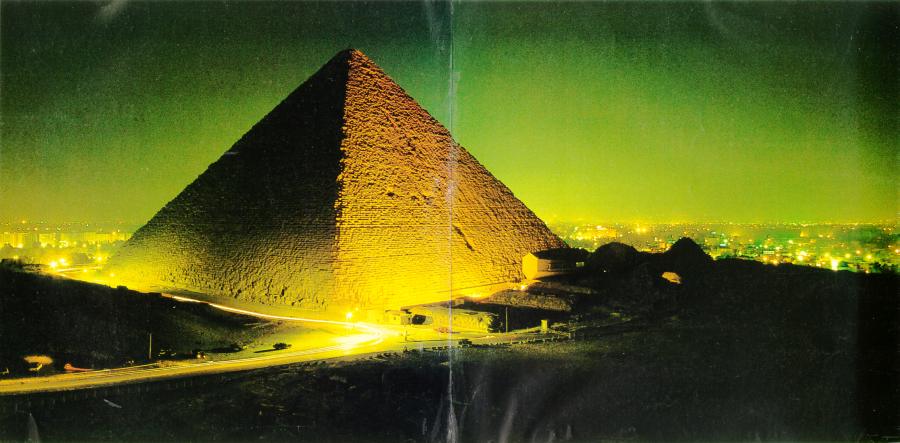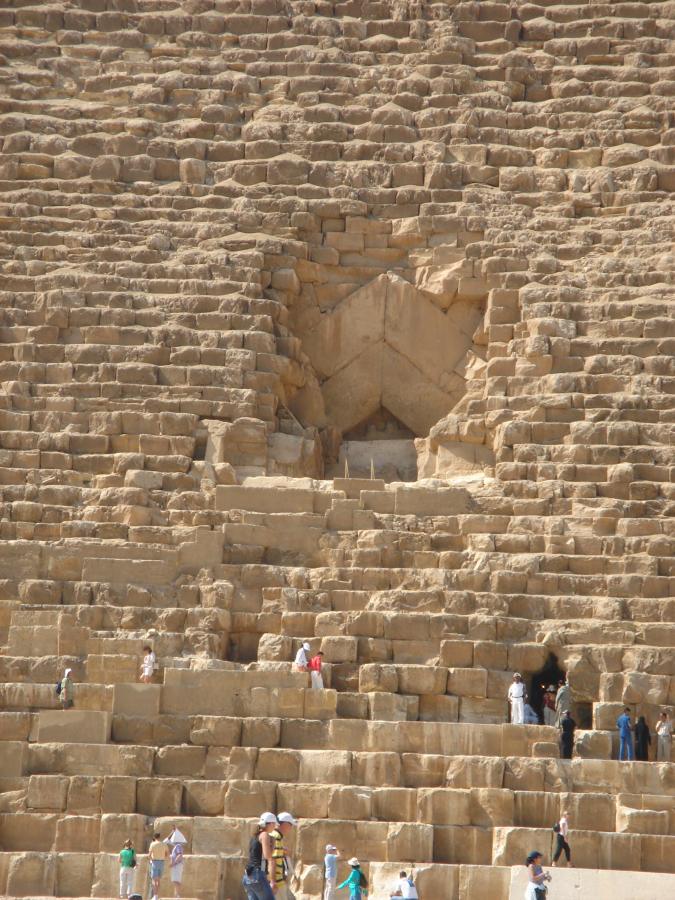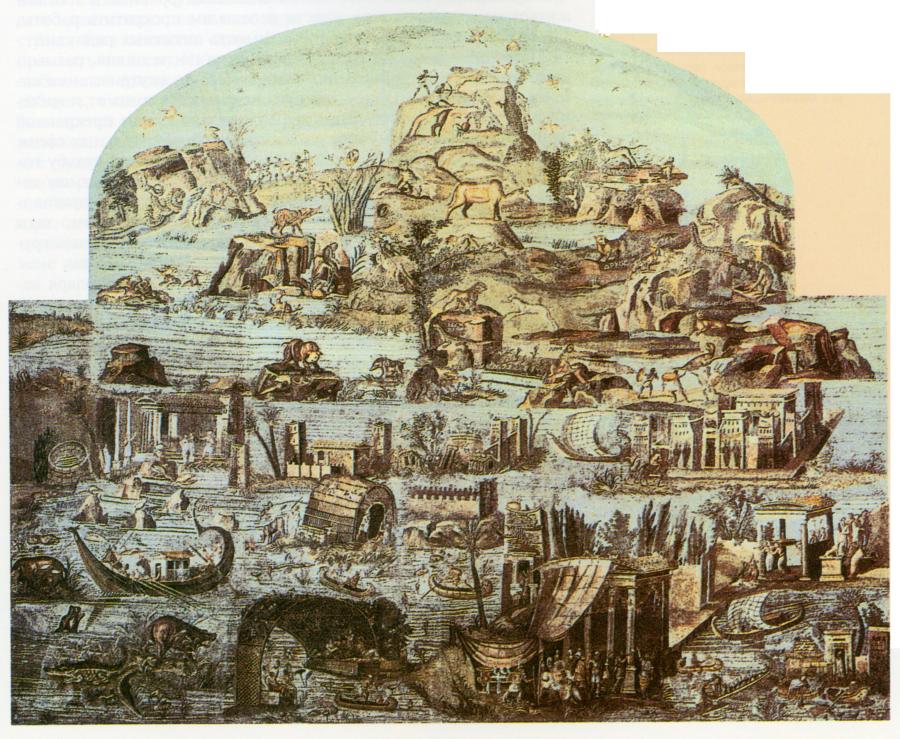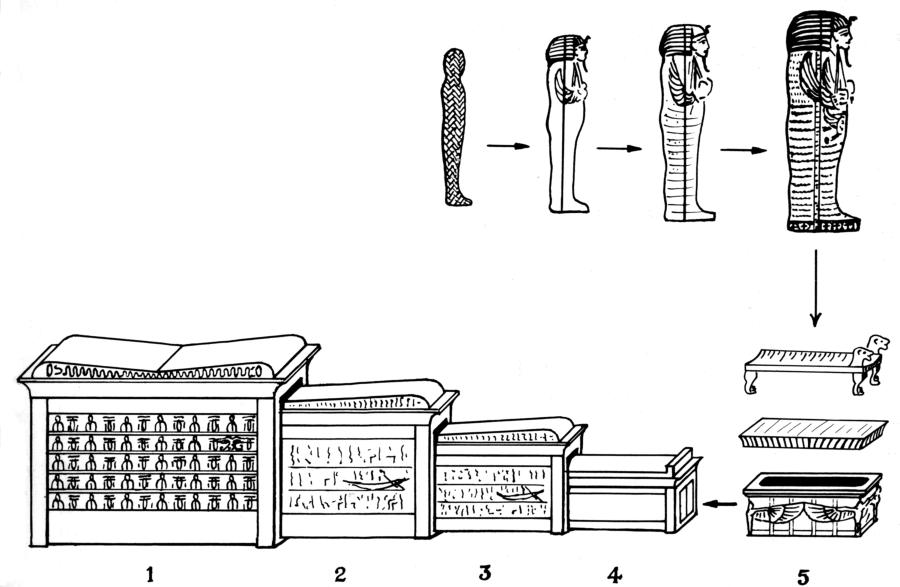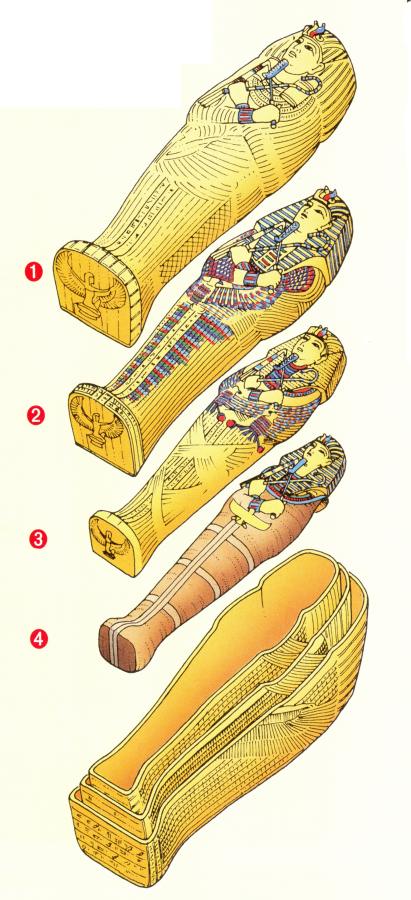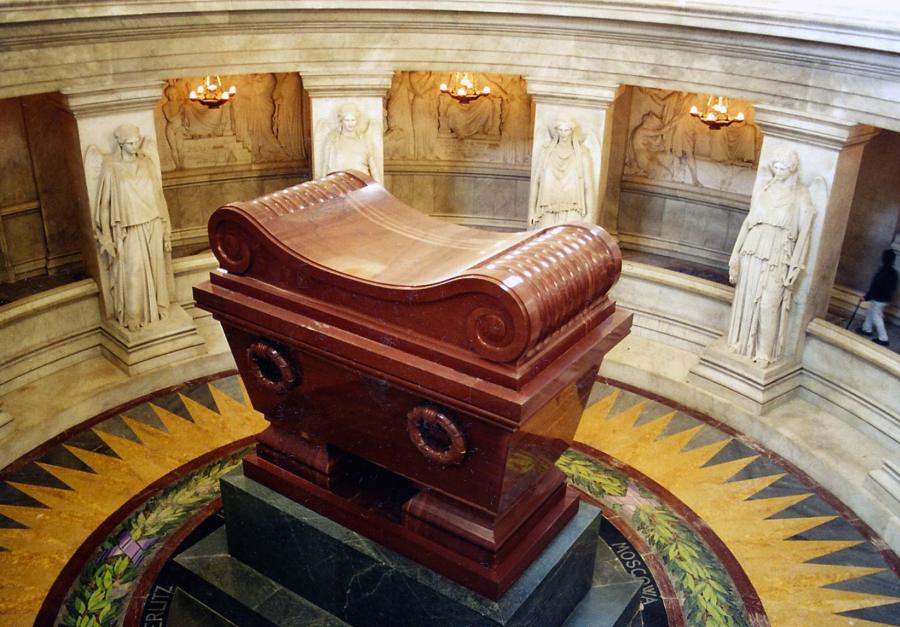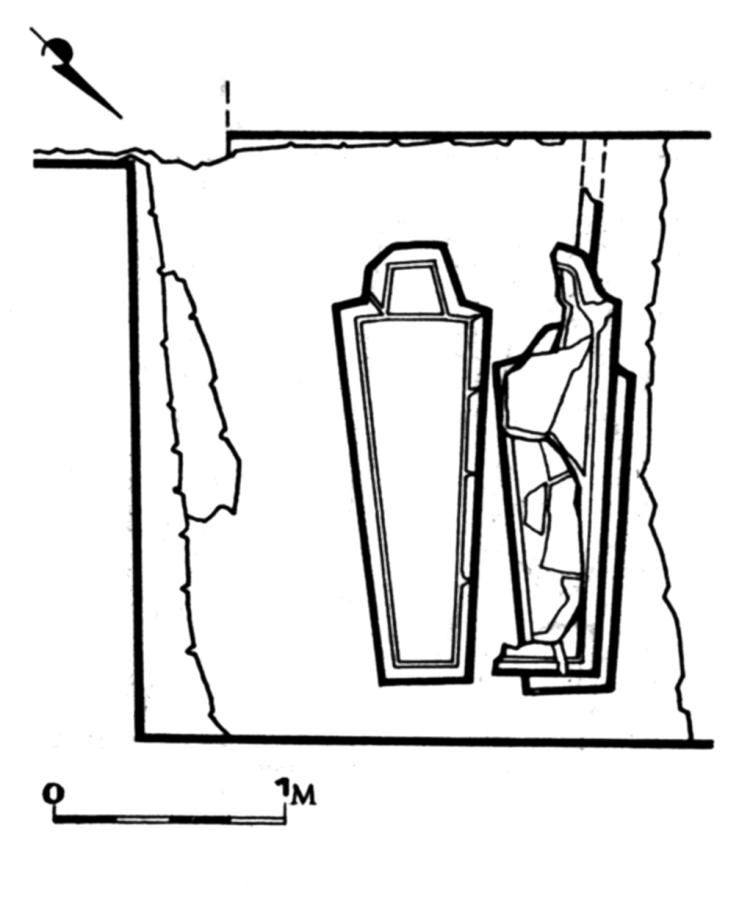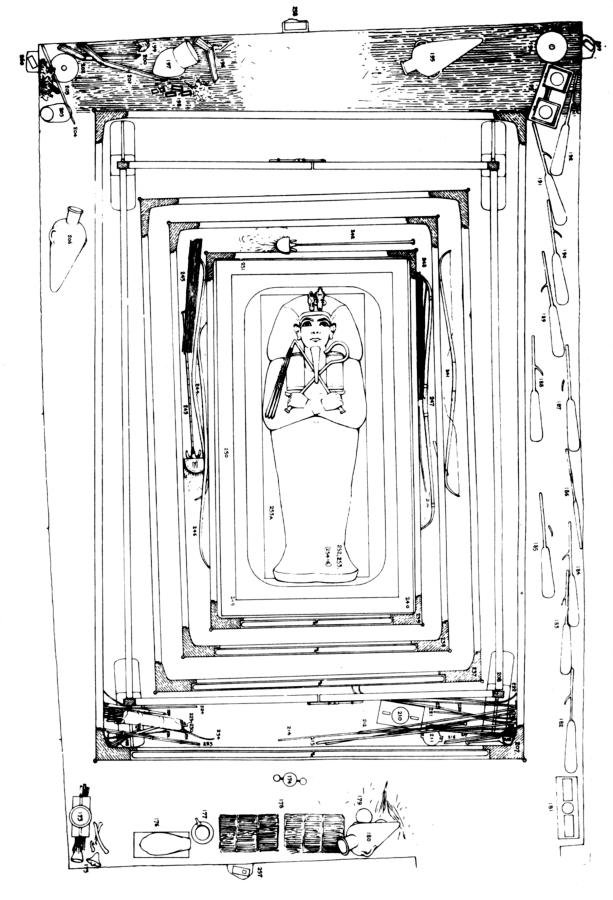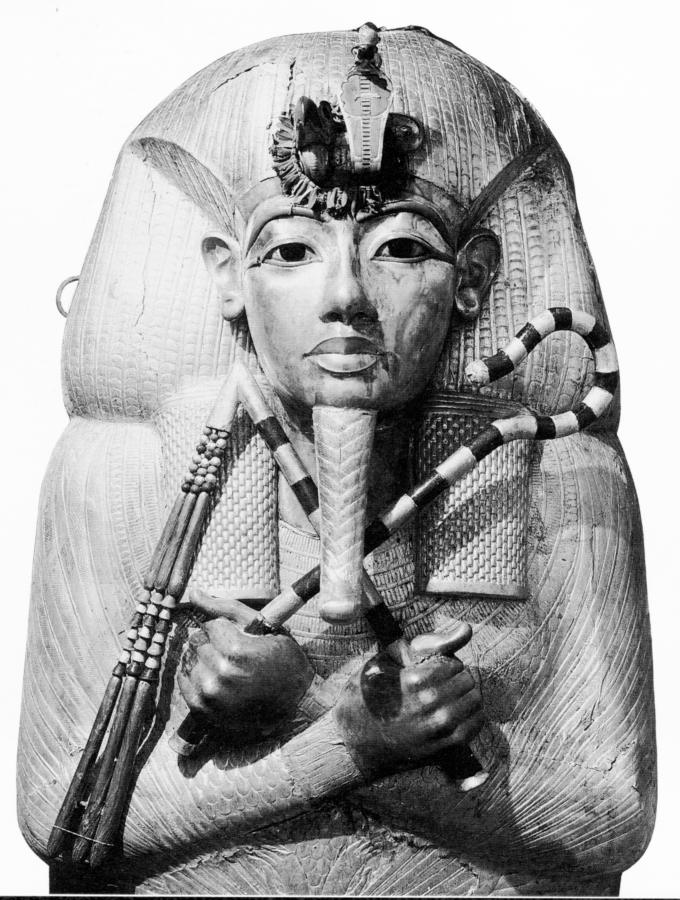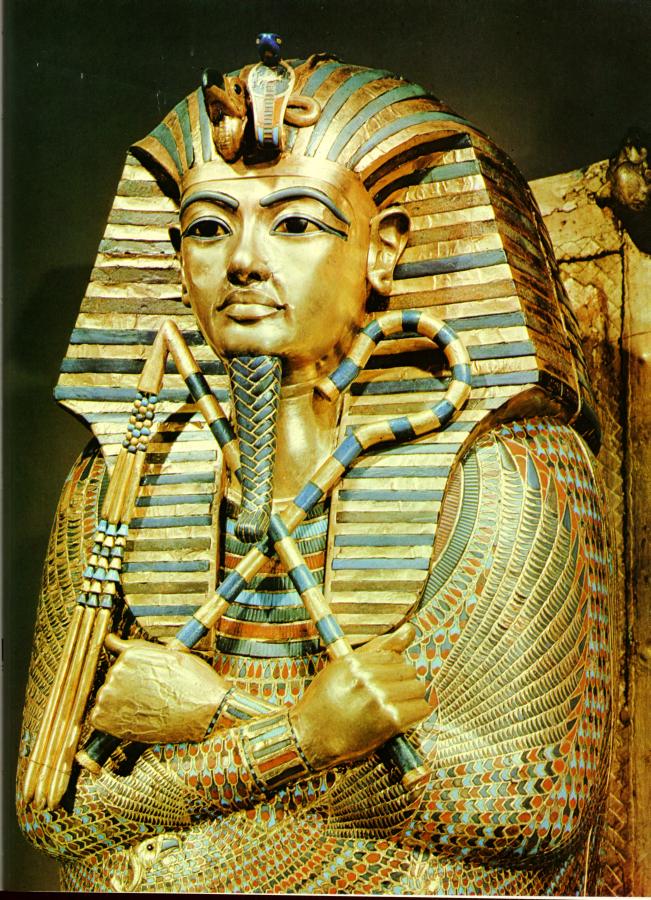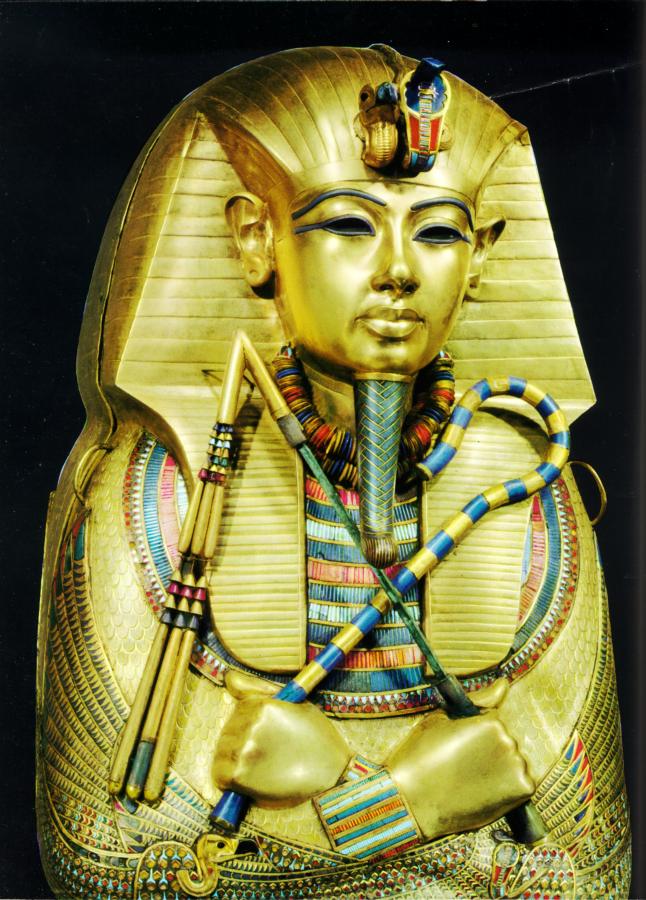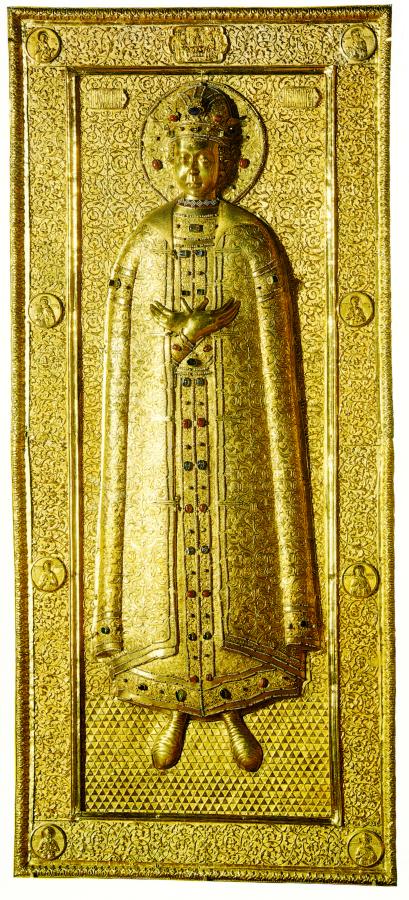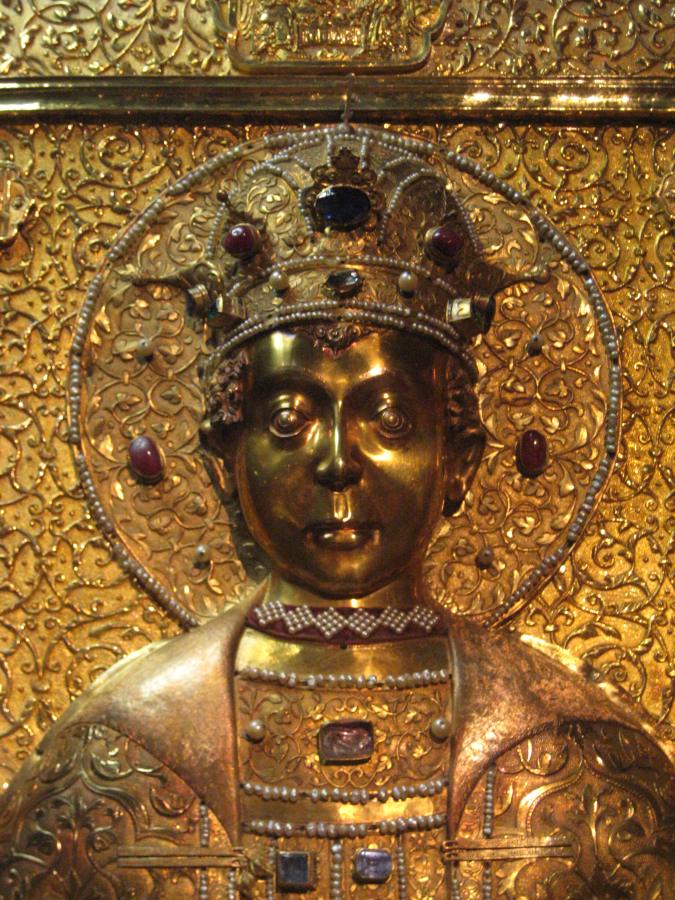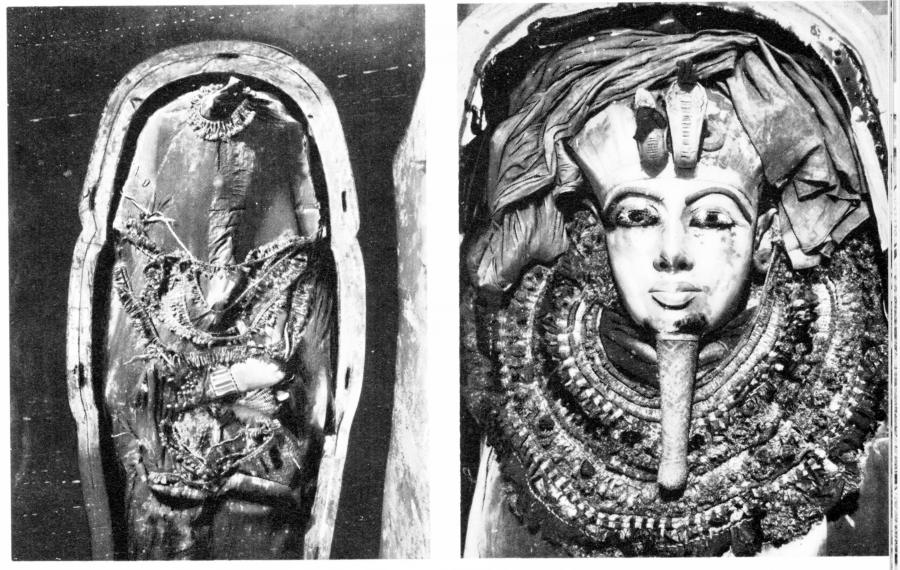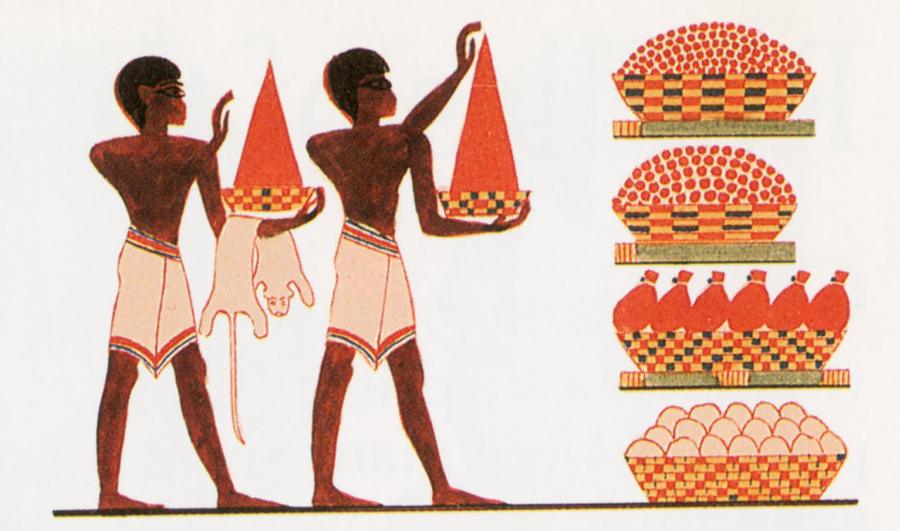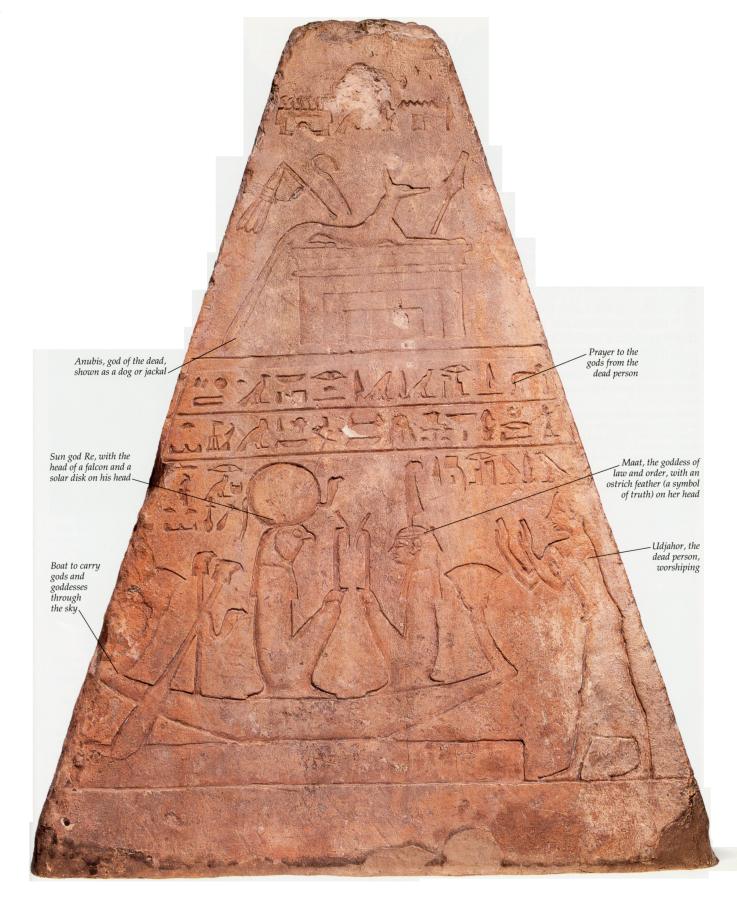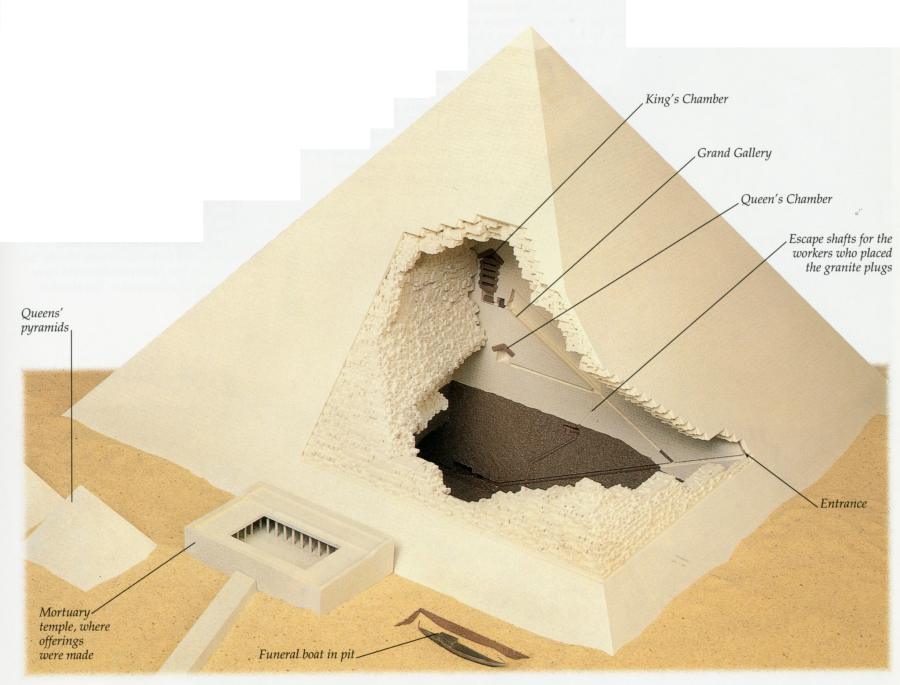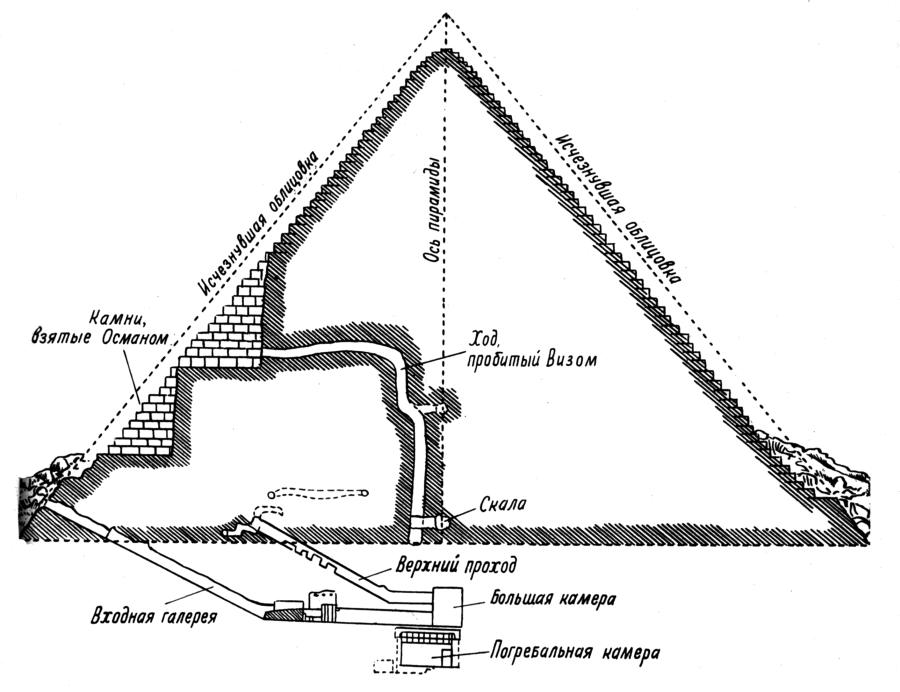Part 5.
Ancient Egypt as part of the Great “Mongolian” Ataman Empire of the XIV-XVI century.
Chapter 19.
“Ancient” African Egypt as part of the Christian “Mongolian” Empire of the XIV-XVI century - its primary necropolis and chronicle repository.
4. Pyramids and sepulchres.
4.1. Who built the Great Pyramid of Khufu (Cheops)? When was it done?
It is believed that the three largest Egyptian pyramids were erected in the epoch of the 4th dynasty of the Pharaohs in 2680-2565 B. C. ([1447], page 254). The three main pyramids are also presumed to have been built in chronological sequence by the pharaohs Khufu (a. k. a. Cheops), as well as Khephren and Mencaur.
The pyramid of Cheops (or the Great Pyramid of Khufu) is the largest (see figs. 19.1 and 19.2). It is said to have been erected after the Great Sphinx ([99]). It is however remarked that virtually no information exists about these three pharaohs; what we have is of legendary nature.
It is commonly known that the scientists haven’t found any traces of the pharaoh’s mummy in the Pyramid of Khufu. As a result, they were forced to claim the “body of the king commemorated with the construction of the Great Pyramid has never been buried there” ([464], page 54).
“Thomas Shaw, who visited Egypt in 1721 . . . shares his opinion that the internal construction of the Great Pyramid is very poorly suited for funereal purposes . . . believing that in reality they [the large pyramids in general and the Great Pyramid in particular - Auth.] weren’t sepulchres. He believes . . . the granite sarcophagus of the Great Pyramid to have been used for mystery rites in honour of Osiris. According to Shaw, this sarcophagus, which isn’t decorated by any hieroglyphic inscriptions, differs from authentic sarcophagi shape-wise, being much taller and wider” ([464], pages 58-59).
As a result of the archaeological excavations conducted in the XIX century it was discovered that the large pyramids and “the first pyramid in particular, weren’t merely large sepulchres; they miss too many important features for this application. After all, nobody has managed to prove that any kings were ever buried there” ([464], page 71). As for the second and the third pyramid, some remains have reputedly been found there ([464], page 78). It is therefore possible that these pyramids served the purpose of sepulchres at some point. However, no traces of burials have been found in the first, or the Great, pyramid to this day ([464]).
The “ancient” Herodotus wrote about Pharaoh Khufu and his pyramid. As we are beginning to understand, this took place in the XV-XVI century of the New Era or later. Herodotus writes: “Cheops, King of Egypt, brought all sorts of misfortune upon Egypt. First of all, he locked up all the temples and forbade the Egyptians to make offerings. Then he made all the Egyptians work for him . . . The construction of the pyramid lasted for 20 years” ([464], page 33).
Now let us return to Pharaoh Khunaten (Khan of Don?), or Amenkhotep IV. It turns out that he was the very builder of the Great Pyramid. This is what an “ancient” Egyptian inscription tells us in Brugsch’s translation:
“And the first time the king sent his order to . . . [chisel marks - Auth.] so that all builders would gather around, from the city of Elephantine to the city of Samkhud . . . and all the leaders and rulers of the nation, to break strong rock for the construction of the Great Pyramid of Khormakhu, glorifying him as the god of light . . . The great and distinguished rulers and lords . . . became whipmasters at quarries and harbour” ([99], page 408).
We are clearly being told that it was Pharaoh Khunaten (Khan of Don?) who built a “Great Pyramid” of some sort. However, none of the surviving pyramids are associated with the name of Khunaten by the Egyptologists. The main reason is their opinion that all the great pyramids were built thousands of years before his reign; it is said that no large pyramids were built under Khunaten.
Repercussions of the Great Pyramid’s construction under Amenkhotep IV must have been reflected in the “biography” of his immediate predecessor, Amenkhotep III. This is what the writing that speaks on behalf of its main builder tells us: “The king made me Head of the builders. I made the King’s name immortal; there is nobody to surpass my feat, even among the ancients. A great mountain of sandstone [pyramid? - Auth.] was built for him (the king)” ([99], page 393).
Egyptologists believe that Khunaten’s pyramid was indeed constructed, but . . . it did not survive. Brugsch writes: “His first deed [one of the next pharaohs - Auth.] was to destroy and deconstruct the building of Khunaten, who had . . . built a gigantic pyramid in the middle of Ammon’s city, the so-called Ben-Ben, which was topped with a solar sphere and devoted to Aten, his only deity” ([99], pages 426).
Mark Brugsch’s cautious approach - he is simply referring to “the deconstruction of a building”, but doesn’t make any comments concerning the fate of the pyramid, as though he was suggesting that the readers could make their conclusions themselves, the implication being that if even a building was taken apart, the pyramid would definitely meet a similar fate. Why is Brugsch so cautious about his claims? The reason must be that the original sources do not contain any passages where one could find explicit references to the deconstruction of the Great Pyramid built by Pharaoh Khunaten. This is why the eminent Egyptologist was forced to explain its conspicuous absence today, on the one hand; on the other hand, he feels too embarrassed to claim that a gigantic stone mountain was also “pulled apart and rendered to individual stones by some mysterious party”.
What do we come up with? The “ancient” history of Egypt almost completely fits into the relatively brief historical period of the XIII-XVI century A. D. We are not currently concerned with the early and nebulous, or legendary, period of the XI-XII century.
The Khufu pyramid was built after the Great Sphinx or simultaneously with the statue ([99], page 753). This is confirmed by the stele that says: “It is said elsewhere that King Khufu saw this monster; in other words, this sculpture had existed before him and was created by the most ancient of the pharaohs” ([99], page 133).
The Great Sphinx is most likely to have been built by the Hiksos, or the Horde, in the alleged XIV century A. D., as we have already seen. This is four thousand years later than it is considered to be by Scaligerian “chronology”.
It is time for us to voice our hypothesis. It shall be simple. According to our opinion, the Great Pyramid was erected at the end of the XIV century A. D. the earliest. This places it in the epoch of the Ataman, or Ottoman dynasty of the sultans, or pharaohs. Only one of them is said to have built a large pyramid - Khunaten (possibly, Khan from the Don).
Therefore, the Great Pyramid was built by Khunaten in the late XIV - early XV century A. D. the very earliest. It is for this very reason that Herodotus reports the use of iron tools at the construction of the Great Pyramid ([163], page 119, Book of Eutherpes, passage 125). As applied to the XIV-XV century of the New Era, this fact ceases to surprise and becomes perfectly normal. Anything else would be strange. It is also perfectly clear why a steel chisel was found in the masonry of the Khufu pyramid ([245], page 27, comment 23). However, modern Egyptologists are greatly influenced by the Scaligerian chronology, which makes them “correct” Herodotus. For instance, in [464] this quotation from Herodotus is accompanied by the following dry comment, which isn’t backed up by any solid facts whatsoever: “In the epoch of Cheops, or the first half of the III millennium B. C., Egyptians used copper tools exclusively. Editor” ([464], page 34).
The name Khuphu, or Khut obviously stands for “Goth”, and may be regarded as a modification of the name Khunaten. The latter could have derived from “Khunat” - “The Huns” (or the Goths); alternatively, it might stand for “Khan of the Don”. Apparently, the legends about Pharaoh Khufu (the Goth) are simply another reflection of the biography of Khunaten (Khan of the Don) - the great religious reformer of the Huns.
Sources where we find references to Khufu report that he had closed all temples and forbade offerings, or, in other words, instigated a great ecclesiastical reform, which brought turmoil and strife to the country.
Just like Khufu, who “made every Egyptian work to serve his needs” ([163], 2:124, page 119), Khunaten sent everyone to build the pyramid - not just the mere folks, but also “the great and distinguished lords and rulers”, qv above.
Likewise Khufu, who was hated by all Egyptians so much that they are even believed to have refrained from calling him by name ([163], 2:128, page 120), Khunaten is also said to have become unpopular after his mandatory pyramid construction decrees ([99], page 405).
This is what the Egyptologist Brugsch tells us about Pharaoh Khufu: “Hufu had an ill fame. Tradition has it that Khufu was coarse and despotic, and that he enjoyed making people work hard . . . Egyptians hated him so much that his name remained taboo for many years after his death” ([99], page 130). Simultaneously, other sources “portray him as a brave and industrious king” ([99], page 130).
All these parallels between the “biographies” of Khufu and Khunaten must result from the fact that different sources refer to the same Hun (or Goth) - the Khan of the Don. Scaligerian chronology separated two different reflections of the same figure by nearly a millennium and sent both into deep antiquity. We bring them together again and restore them to their actual chronological location - the XIV-XV century of the new era. This makes the image of the great reformist and the builder of the great pyramid more vivid and saturated.
“There is a writing on the rock in Vadi-Magara that glorifies Khufu as the destroyer of his enemies. The inscriptions on the sepulchres of the Nile Valley call Khufu builder of many cities and settlements on the bank of the river . . . Inasmuch as a researcher can judge by the inscriptions that survived inside sepulchres adjacent to the Great Pyramids, the Field of Gizeh was chosen as the burial ground of royal infants and noblemen from the epoch of the fourth dynasty” ([99], page 131). Since the fourth dynasty is the actual reign of Khufu, Khephren and Mencaur, or the builders of the three largest pyramids, the epoch in question is most likely to identify as the XIV-XV century and not any earlier. Incidentally, the “hieroglyphica name of the pyramid was Khoot” ([99], page 750). “Goth” once again! We see obvious clues concerning the origins of the Mameluke dynasty, as in the case of the pharaoh’s name - references to the Mamelukes, the Goths and the Cossacks.
Let us conclude with a recollection of the opinion voiced by Herodotus about Khufu having lived after Ramses II, while the modern commentators “explain” it to us that Herodotus was wrong and the real order should be the reverse ([163], page 119; also [163], page 513, comment 138). Nowadays we can finally determine whether Herodotus had actually been correct or not. As we can see, the criticisms of his Scaligerite adversaries are completely unjustified, since Ramses II does predate Khunaten, or Khufu, according to our reconstruction.
4.2. The two other large pyramids.
The second large pyramid was erected by Khephren, who was also known as Khaphra, Kephren and Habries. He was a brother or a son of Khufu ([99], page 131). His name, Khaphra (Hat-Ra, Khet-Ren or Khab (t) Ries obviously includes the “Hittite” root “Khet”, which is synonymous to “Goth”. The name Khet-Ra may have translated as “King of the Goths”. With “Ries” or “Rus” we shall read the name as “Russian Goth”, or once again as “Goth-Rex” (“King of the Goths”). Also, could the name Habries be a slight corruption of the Slavic word “khrabriy”, which stands for “brave”?
It is reported that “the pyramid of this king was called Urt, or “the Great”; it stands right next to the Pyramid of Khufu” ([99], page 131). The name Urt is very similar to the word Horde = Artha = Rat (the army), as well as to “Ruthia” (or Ruthenia). ALl of the above is in good correspondence with our reconstruction.
The creator of the third large pyramid was known as Mencaura or Menkheres ([99], page 135). The name “Menkheres”, or “Meng-Res” might be a repercussion of Mong-Res or Mong-Rus - the “Mongolian” (Great) King, or the “Russian Mongol”.
Here is the name of another pyramid, which has fortunately survived: “After Merenrah [the Marine King? - Auth.] his brother Noferkarah ascends to the throne. His pyramid was called Menkh-Ankh” ([99], page 150). This name sounds similar to “Mongol-Khan”.
However, Herodotus reports the following: “One count a 106 years during which the Egyptians were afflicted by all sorts of troubles, and their locked-up temples didn’t open. Egyptians loathe these kings so much that they’re reluctant to say their names aloud, ascribing the pyramids to the shepherd Philitis, whose herds were grazing in these very fields, as the legend tells us” ([464], pages 304-305).
It is obviously useless to interpret this text literally. It is unlikely that a shepherd, even a very gifted one, could have built the three greatest pyramids of Egypt in spare time - or just one of them, for that matter. The Khufu pyramid weighs around 6.5 million tons. Such outstanding shepherds only exist in Scaligerian chronicles.
However, let us recollect that the term “shepherd” was applied to the Hiksos dynasty, qv above. Therefore, the words of Herodotus are likely to mean that the Egyptians ascribed the construction of the pyramids to the Hiksos dynasty, or the first Orthodox dynasty of the Cossack Pharaohs that reigned as such until the introduction of Islam by Khunaten or one of his heirs at the end of the XVI century. The next Egyptian dynasty was the “Lunar dynasty” of the Ottomans, who were Muslims.
Apparently, Herodotus, being a Greek, contacted with the Orthodox Coptic populace of Egypt. One must think that the XVI-XVII century Copts weren’t too fond of their new Muslim rulers. On the contrary, the old Orthodox dynasty of the “shepherd” kings was remembered with warmth.
By the way, shortly after 1550 A. D. “Pierre Belon, the doctor of the Parisian Faculty of Medicine, published the description of his journey to the Orient, wherein . . . he said that the third pyramid was in such an excellent condition that the impression one got was that it was just built” ([464], page 48). Everything is perfectly correct - our reconstruction claims that it was indeed built a short while earlier.
In this regard, let us pay attention to the Roman inlays of the alleged II or III century A. D. depicting the “ancient” Egypt ([726], page 100). We reproduce it in fig. 19.3. Modern historians write the following about them: “These artful Roman inlays of the II or III century A. D. very skilfully depict the miracles of the Nile Valley - from the source lost in the Ethiopian mountains to the delta of the river and the city of Alexandria” ([726], page 101).
What do we see on the inlays dedicated to the Egyptian miracles? Oddly enough, this ancient artwork doesn’t depict the Egyptian Pyramids, or the Great Sphinx, or any of the other famous constructions dated to deep antiquity. How could it possibly be? After all, we are being told that the pyramids and the Great Sphinx were built many centuries before the beginning of the new epoch. Yet the author of the inlays that date from the alleged II-III century for some reason know nothing about these grandiose constructions, despite the fact that Egyptian pyramids rank among the seven wonders of the “ancient” world. Incidentally, according to Scaligerian history, in the epoch of the II-III century A. D. Europeans didn’t have any problems with travelling to Egypt. Therefore, if we’re to remain within the confines of Scaligerian history, the authors of the Roman inlays must have somehow reflected the Great Sphinx and the pyramids in their artwork.
The corollary is very simple. Neither the great pyramids nor the Great Sphinx existed in the epoch when this detailed inlay was made. We encounter yet another serious contradiction inherent in Scaligerian history.
It is however possible that the inlay dates from the time when Europeans were no longer allowed in Egypt. This epoch is known to us well enough - the XVI-XVIII century when Egypt became virtually closed by the West Europeans.
We believe that this truly remarkable Roman inlay was created in the XVI-XVII century, when the mutinous Reformist Europe, already separated from African Egypt by religious and ideological barriers, the conception of Egypt became rather blurred. There was some memory of certain wonders, but vast arrays of actual data were lost. Westerners only returned to Egypt after the Napoleonic invasion to “rediscover the country”.
Coming back to the inlay, one instantly notices just how evasively and cautiously historians comment it ([726], page 101). Haven’t they noticed the absence of the pyramids, the Great Sphinx and the rest of the famous monuments associated with the “ancient” Egypt? They must have - as we see, they chose to remain silent about the whole affair so as not to draw any attention to this circumstance, which is truly amazing within the framework of Scaligerian history. The latter instantly turns out to conceal many grave inconsistencies.
4.3. The sarcophagi of the Pharaohs and the Russian matryoshka dolls.
4.3.1. The structure of an Egyptian sarcophagus.
It is commonly known that the Egyptian sarcophagi that used to contain the mummies of the pharaohs were designed in a very ingenuous way - there were several concentric coffins of different size, and the mummy was in the smallest one. Each of the coffins had the shape of a human figure, hollow inside - with a face and wearing a hat, dressed in garments adorned with symbols of power. Each coffin was painted and lavishly decorated. Thus, the scheme of Tutankhamen’s multilayer sarcophagus is reproduced in figs. 19.4 and 19.5.
Incidentally, the six “telescopic” coffins found inside a stone sarcophagus served Napoleon as a final resting place after his second burial in 1861 ([1329], page 74 and [1272], page 153; see also fig. 19.6). The creators of this sepulchre in Paris obviously wanted to make the decorations as luxurious as possible - hence the design.
Doesn’t the design strike the reader as familiar? Of course - the first thing that comes to mind is the famous Russian matryoshka doll - several hollow figures housing smaller figures. Only the last one isn’t hollow. Each doll is painted and represents a human being. To the best of our knowledge, this symbol, or the matryoshka doll, is only typical for Russia these days.
It turns out that the “ancient” Egyptians were also familiar with the matryoshka design.
Could this mean that the Russian folk art has preserved the memory of an Old Russian tradition - namely, to bury kings in telescopic coffins? It would be natural to expect that the Czars, or Khans, of the Horde (Russia) and the Ottoman (Ataman) Sultans of the XIV-XVI century would be buried in the imperial graveyard of African Egypt in accordance with this Russian custom.
4.3.2. The anthropomorphic sarcophagi of Suzdal and Vladimir Russia.
Our opponents might want to ask whether any such “telescopic” sarcophagi were found in Russia.
We shall reply as follows. Apparently, today we are already confused about the old Russian customs common for the Horde, which also concerns the burial rites - this means every epoch that precedes the first Romanovs. In CHRON4, Chapter 14:6, we cite some data to prove that the Romanovs instigated an ecclesiastical reform between 1632 and 1636 - in particular, this concerned Russian burial rites, which were changed drastically. Then, as we have told the reader earlier, the old Russian cemeteries were raided and in many cases destroyed.
One feels obliged to note the old Christian graves of the pre-Romanovian period that look strange from the modern point of view - namely, anthropomorphic sarcophagi, or coffins shaped in the image of a human body ([305]). The “ancient” Egyptians did the same!
These customs were the strongest in the so-called “Russia of Vladimir and Suzdal”, or the Russian Northeast. It goes without saying that modern historians believe the Russian anthropomorphic sarcophagi to be copies of Egyptian originals. However, New Chronology suggests a different approach to the relation. The direction of imitation was probably the reverse, and the “ancient” Egyptians learnt of such sarcophagi from Russian invaders hailing from the Vladimir and Suzdal area during the Great = “Mongolian” conquest of the XIV century.
Let us reiterate that, according to our reconstruction, the great Czars, or Khans, who reigned in Russia and the Horde, were buried in African Egypt up until the XIV century - in the holy Gizeh (Cossack) Pyramid Field and in Luxor. It was only after the decomposition of the Great = “Mongolian” Empire into the Orthodox Russia and the Ottoman (later Muslim) Turkey that the Orthodox rulers ceased to be brought to Egypt for their burial. This was when the pyramid field ended up belonging to the Muslim part of the Empire.
One must note that the anthropomorphic sarcophagi are constantly found in Moscow during archaeological excavations ([62]). For instance, the anthropomorphic sarcophagi of white stone dating from the late XV - early XVI as found in the excavations at the former Bogoyavlenskiy Monastery next to the Kremlin (see [62], page 79, tables 54, 55 and 56). These Russian stone sarcophagi were shaped as human bodies with shoulders and heads (figs. 19.7 and 19.8). Researchers know of many such sarcophagi; they are classified by the shape of the head part. For instance, the anthropomorphic sarcophagi found in Moscow are recognized by a certain angulous style ([62], page 82). The anthropomorphic sarcophagi with more rounded features are considered more ancient ([62], page 82).
Incidentally, we must remark that the Romanovian and Millerian history reluctantly acknowledges the change of religious customs in Russia, but dates this event further back into the past - the alleged epoch of Ivan III. We are told that “the Great Prince [or Ivan III - Auth.] instigated a change of customs” ([435], page 376). However, we already know that Ivan III is a phantom reflection of Ivan IV the “Terrible”, and so the events in question might date from the second half of the XVI century. In reality, as we feel obliged to mention once again, the change of religious customs took place under the Romanovs, between 1632 and 1636 (see CHRON4, Chapter 14:6). Major ecclesiastical reforms were conducted in Russia - in particular, the burial rites were brought closer to their Greek counterparts. The architecture of the Russian churches has also changed, qv in CHRON4, Chapter 14:47. Apparently, the burial mounds and the “telescopic” sarcophagi only disappeared from Russia in this epoch.
4.3.3. Tutankhamen’s telescopic coffins.
Now let us consider the Egyptian coffins designed as matryoshka dolls that were found in the tomb of Tutankhamen (see figs. 19.9, 19.10, 19.11, 19.12 and 19.13).
We learn the following: “The mummy was placed inside the following construction:
1) A huge wooden chapel covered in plaster and wrought gold over the magic symbols on the relief.
2) Another chapel that resembled the previous one was locate inside it . . .
3) Another chapel similar to the first two was inside the second chapel.
4) The next one was obviously smaller and done in a more austere style . . .
5) Inside the last chapel there was a deluxe sarcophagus made of reddish quartzite whose corners were guarded by four reliefs of winged goddesses . . . The golden hearse was inside; it is hard to understand how it could have supported all this enormous weight for thousands of years” ([484], page 135).
Let us stop the quoting in order to answer the above question. Of course, a golden support would have flattened out after thousands of years. But there were none - as we realize today, four hundred years are the maximum amount of time that could have passed since the burial of Pharaoh Tutankhamen, since the Egyptologists place him at the very end of the “moon-born” Ottoman or even the more recent Islamic dynasty of the Mamelukes. This grave may well date from the very end of the epoch that preceded the Napoleonic invasion, which took place at the very end of the XVIII century.
Consider the splendorous inner coffin of Tutankhamen as shown in fig. 19.12. It is made of gold. We wouldn’t be surprised if somebody told us it was made in the XVIII or even the XIX century of the new era.
Let us carry on with our description of Tutankhamen’s tomb. We haven’t even reached the matryoshka sarcophagi yet, having stopped at the stone sarcophagus that conceals the smaller coffins portraying the pharaoh.
6) “The first actual coffin, made of wood covered with plates of gold, attracts our attention by just a single detail: this is the first time we see the Pharaoh’s face, which is depicted in an austere and simple manner [see fig. 19.10 - Auth.] . . .
7) On the second coffin, which is also made of gilded wood, the pharaoh’s face looks less strict [fig. 19.11 - Auth.].
8) The main coffin, made of pure cast gold, had the weight of more than 200 kg [fig. 19.12 - Auth.]. The metal is thicker than 2 centimetres in a number of places [the average thickness of this coffin is 2.5 - 3.44 mm, qv in [380] - Auth.]. The coffin was adorned with gemstones, glass and some other metals. The pharaoh’s face looks much younger and a great deal less strict, as though it was the face of a teenager. The coffin had cleverly concealed handles which could be used for moving it about and lifting the lid.
9) The mummy turned out to be in a very poor condition, and fell apart due to the effects of the unguents and resins that have all but turned it to dust [in other words, the poor condition that Tutankhamen’s mummy was in does not guarantee its antiquity - Auth.] . . .
10) Another important object is the golden mask [figs. 19.14 and 19.13 - Auth.] made in the same manner as the golden coffin - or, possibly, the artwork here is even finer” ([484], pages 134-135).
4.3.4. The Muscovite coffin of gold.
Let us make the reader mark the fact that Tutankhamen was buried inside a heavy golden coffin. Was there any other country where golden coffins were used? The very lavishly decorated French sarcophagus of Napoleon, for instance, contains the following: a coffin of oak, a coffin of ebony inside it, two lead coffins, a redwood coffin, and, finally, a tin coffin that contained the body (see [1329], page 74). No gold coffin anywhere.
The only mention of a golden coffin that we have managed to find was in re the golden Holy Sepulchre in Moscow crafted at the end of the XVI century at the orders of Czar Boris “Godunov”. The coffin was wrought of cast gold ([305], page 158). 4 angels and 12 statues of apostles were also cast of pure gold, which nobody clearly intended to treat frugally.
“Isaac Massa mentions: ‘He [Czar Boris - Auth.] cast the figures of the 12 Apostles, Jesus Christ and Archangel Gabriel . . . During a great mutiny [already in the epoch of the Great Strife - Auth.], when the royal palace was looted . . . a wax statue of an angel was found there - the late Czar ordered to make one as the prototype of a similar statue that was intended to be cast in pure gold, like the statues of the 12 Apostles’ . . . Elias Herkmann reports likewise” ([305], page 158).
This Russian golden coffin and the golden statues that accompanied it disappeared during the epoch of the Great Strife in Russia, which falls over the early XVII century. “It is known that the Holy Sepulchre of 1599-2500 was stripped of all valuables and destroyed by the Poles under False Dmitriy I” ([305], page 166).
Nevertheless, numerous mentions of the coffin have remained. They demonstrate that contemporaries appear to have “confused” this coffin and a shroud either cast or forged by smiths out of solid gold ([305], pages 158, 250 and 163). However, a shroud is a piece of fabric - like the one that the body of Christ was wrapped up in. The fabric apparently repeated the contours of a body.
Modern commentators still fail to realize the identity of this strange object - a shroud of solid gold. A. L. Batalov, for example, writes the following: “Some sources call it the ‘Holy Sepulchre’, others, ‘The Shroud’ . . . There still is no consensus about its true identity . . . We have to decide whether the object in question is actually a set of two independent objects, the shroud and the Holy Sepulchre . . . and also whether they may form a single work of art” ([305], pages 157-158).
We believe everything to be perfectly easy to understand - Boris Godunov ordered for the Holy Sepulchre to be fashioned as a golden anthropomorphic sarcophagus that would repeat the contours of Christ’s body. Therefore, the coffin was simultaneously a coffin and a shroud. Modern researchers fail to realize this - possibly due to the fact that they cannot think of any other Russian coffin that would look like a human figure complete with a face, arms, legs etc.
The golden “shroud” of Czar Boris was known to his contemporaries as “the Coffin of Jesus the God” ([305], page 16).
This is the very manner that the golden coffin of Tutankhamen was done in, among others - also, it appears to postdate the Muscovite golden Holy Sepulchre, since it couldn’t have been made earlier than the XVI or even XVIII century.
Let us enquire about the existence of a custom to cover the faces of the deceased with a golden mask. We don’t know of any such archaeological findings made in Russia. However, the Russian language still contains a vivid trace of this ancient custom. We mean the well-known term “susalnoye zoloto”, which stands for the kind of gold used for gilding - thin golden foil used for covering uneven surfaces such as carved wood. “Zoloto” is the Russian for “gold”; however, the etymology of the word “susalnoye” remains a mystery to the philologists. For instance, M. Fasmer’s article entry says the following: “An obscure word . . . most likely, of a foreign origin” ([866], Volume 3, page 809). Fasmer cannot tell us anything about the language that the word was borrowed from; he discusses several unsuccessful attempts of the linguists to find a valid explanation thereto, but recognizes them as inconsistent and unconvincing.
At the same time, the previous article from Fasmer’s dictionary ([866] is dedicated to the Russian word “susaly”, which stands for “face”. Today it is considered a rude word translating as “snout”, “gob” and so on (see Dahl’s dictionary, for instance - [223], Volume 4, Column 644). Nevertheless, its meaning remained unaltered - “a face”. Thus, the term “susalnoye zoloto” can be translated literally as “facial gold”, or the kind of gold used for putting over somebody’s face. The meaning of the term has therefore remained unaltered - it has merely become more versatile, and is presently used in the meaning of “gold used for gilding in general”. We see that the Russian language has preserved a memory of the time when the Russians could have made golden masks for their dead.
Why hasn’t this obvious idea occurred to M. Fasmer and his colleagues? Apparently, the reason is that their concept of the Russian history made the very thought of golden masks coming from Russia and referred to by a special term an utter heresy. Otherwise, the question about Russian burial masks would have led to a great many other questions, just as interesting.
And so, why don’t we see any golden masks in our museums today? The first reason is the same why the golden coffin, or shroud (qv above) has vanished without a trace. Gold gets stolen and remelted as a rule. Apart from that, everything that we have learnt about the distortion of the “ancient” Russian history makes it possible that archaeological findings that had contradicted the Romanovian version of the Russian history got destroyed.
A precious few objects have nevertheless survived until the present day. The Armoury of the Muscovite Kremlin exhibits the lid of luxurious precious coffin of Prince Dmitriy. Its dimensions are 157 x 70 cm, qv in fig. 19.15. This bas-relief is a Russian masterpiece that dates from the first half of the XVII century and looks like a gilded shroud, or coffin. We see cast silver and gold, repoussé work and gemstones. The three-dimensional gilded figure on the lid of the coffin reproduces the shape of the prince’s body. He appears clad in precious metals as though they were garments. Tutankhamen’s coffins are the same in design. The three-dimensional golden mask of Prince Dmitriy apparently copies the features of his face (see fig. 19.16). The Egyptian craftsmen that put a heavy golden mask over the face of Tutankhamen must have been after the same effect. The three-dimensional figure of Prince Dmitriy apparently confirms our thought that the custom of burying the rulers of the Horde in golden shroud-like coffins existed in the pre-Romanovian Russia.
4.3.5. The mining of gold in the Middle Ages.
We shall quote a remark made by Professor I. V. Davidenko (Moscow), Doctor of Geology and Mineralogy.
Before the XIX century, the famous gold mines were as follows:
1) The largest ones were in Russia (Ural, Uzbekistan etc),
2) India,
3) North Africa.
North African mines are very small, although there are many of them. Gold from North Africa is easy enough to tell apart from the Russian or the Indian, since it contains arsenic. Russian and Indian gold is pure, whereas the gold that comes from North Africa is contaminated by arsenic, which scientists have only learnt to filter our recently. Therefore, a modern analysis can easily identify gold used in the creation of an “ancient” artefact as Russian or African. Was any such analysis of the “ancient” artefacts ever made - Egyptian ones, for instance, such as the golden mask and the golden coffin of Pharaoh Tutankhamen? Apparently not - the suspicion is based on the fact that the gold mines of North Africa couldn’t have yielded a sufficient amount of gold, whereas the South African gold mines were discovered very recently. The answer is easy enough to get - one must simply want to ask it.
4.3.6. Wreaths from Tutankhamen's sepulchre.
Incidentally, some of the plants found in Tutankhamen's sepulchre didn't grow in Egypt back in the days of yore. Three wreaths were discovered in the sepulchre; two of them can be seen in fig. 19.17. According to [374], eight of the plant species represented in those wreaths were identified successfully - the following ones in particular:
- Cornflower (Centaure depressa, M. Bieb). It is noted that "the plant doesn't grow locally in Egypt" ([374], page 260).
- Mandrake (Mandragora officinalis, L.). Also, "not a local species in the Valley of the Nile" ([374], page 261).
- Olive (Olea europea, L.). Comment: "Grown in just a few gardens of Upper Egypt" ([374], page 261).
- Willow (Salix safsaf, Forsk.). Once again, we are told the following: "Only occasionally found . . . on the territory of Egypt" ([374], page 261).
Thus, half of the unidentified plants can also be suspected of a non-Egyptian origin.
4.3.7. Pyramidal gravestones in Russia.
Actually, the Egyptian pyramids are but large burial mounds carved of stone. Let us recollect which nation had the custom of burying the dead under large mounds. The Scythians, of course - or the ancestors of the Russians (see Part 6).
The archaeologist L. A. Belyaev's article entitled "Jerusalem Motifs on the Headstones of Mediaeval Moscow" ([305], pages 148-151) contains the conclusion that the author made during his research of certain modern archaeological findings - namely, that the ancient Russian headstones were more complex than just a single slab of stone, and had a pyramidal shape. Apart from stone, these pyramids could also be made of turf. The pyramids usually had three sections: "The three-section white headstone complemented with a wooden cross looks like a model of the Golgotha [or "Pyramid Mountain" - Auth.] and the Crucifix" ([305], page 149).
4.4. Arabic lettering on the pyramids.
We have thus voiced the hypothesis that the Great Pyramids were built in the XIV-XVI century A. D. However, this brings us to the obvious question - that was the epoch when the culture known as Arabic today started to emerge in the North of Africa. Are there any inscriptions anywhere on the pyramids that could be identified as Arabic today? Indeed, their absence would be most odd.
Such inscriptions do exist, although they are few and far between. "Goyon . . . has found an Arabic inscription dating from the XIV century . . . on the stone lining [of the Great Pyramid - Auth.] . . . On the northern wall of a large gallery there is an even older Arabic inscription discovered by Wilkinson . . . It was engraved to commemorate the Bahrid Mamelukes - Aybek and Beybar, whose reigns began in 1250 and 1260, respectively" ([464], page 43). We already know that the Mamelukes can be identified as the Cherkassian Cossacks.
Egyptologists are obviously of the opinion that the Arabic lettering was carved much later than the pyramids were constructed. We believe that some of the inscriptions may have been there from the word go - especially considering the reference to the mediaeval Mamelukes, or the Hiksos, or the Cossacks. As we realise, the pyramids were erected in their epoch.
Also, there is an Arabic inscription on the western wall of the Khefren Pyramid's tomb ([464], page 77).
Apart from that, we must mention the finding made in the fifth pyramid - "a sarcophagus similar to the ones found in Khefren Pyramid . . . No sculptures or hieroglyphs were found in the tomb - nothing save a few lines from the 112th Sura of the Koran, which could be read on the plaster that covered the southern wall" ([464], page 83).
It turns out that similar Arabic inscriptions were found inside a few other pyramids - the second and the third in particular, or the pyramids of Khefren = Russian Goth and Mencaur = Mongol Czar, qv above ([464], page 83).
Therefore, one can hardly complain about the total absence of Arabic inscriptions from the pyramids.
4.5. The Egyptian pyramids, or burial mounds, and "Paskha", the ritual Christian pastry.
As we have pointed out above, Egyptian pyramids are most likely to be yet another modification of the Scythian burial mounds. On the other hand, modern Egyptology is "still clueless about the origins of the word 'pyramid'. According to a popular opinion (see E. Littré, Dictionnaire de la langue française, Paris, 1886; also A. Erman, Die Religion der Aegypter, Berlin, 1934), the word 'pyramid' is derived from the Greek 'pyramis' (cf. 'pyros'), which stood for a certain kind of pastry made of honey and flour. These pastries were conical in shape, and the Greek pilgrims likened them to pyramids" ([464], page 49).
The readers may have already guessed the exact nature of the pyramidal pastry as mentioned by the Greeks - Orthodox Christian pilgrims (incidentally, one must note that the pyramids were the actual destination of their pilgrimage). Indeed, this Christian Orthodox symbol remains alive until this very day - it is known as "Paskha". This pastry has the shape of a pyramid, whose sides usually depict an egg, a ladder and the letters ХВ, which stand for "Christ Resurrected", a standard ecclesiastical formula. Nowadays the "Paskha" is usually made of cottage cheese, but it may well have been baked in the days of yore.
Therefore, we see that the Egyptian pyramids, or burial mounds, symbolise Christian Easter, likewise the "Paskha" pastry. As it was mentioned earlier, the final religious schism between Islam and Orthodox Christianity occurred as late as in the XVII century. Under Khunaten, Islam must have made its first steps towards becoming an independent religion, so there is nothing surprising about the fact that a Reformist ruler could erect a pyramid to commemorate the Easter.
The fact that the Egyptian pyramids and the Christian "Paskha" pastry are in fact the same symbol isn't even a hypothesis of ours (see above). We have learnt this from a number of ancient documents.
As it turns out, the famous "ancient" author Pliny traces the word "pyramid" to the Greek "pyros" ("flame", qv in [464], page 49). Since the Egyptians confused the sounds "R" and "L", the word "pylamid" would be very close to the Slavic equivalent of "pyros", which is "plamya". The Greek root is manifest in a number of modern words as well.
Therefore, the Russian words "pirog" ("pie" or "pastry"), "plamya" ("flame") and "piramida/pilamida" ("pyramid") possess a common root - it could be that they are all derivatives of the Slavic "plamya".
Even if we don't swap "R" for "L", the word "pyramid" is close to the Slavic word "pir", which translates as "feast" or "ceremonial dinner". This possible proximity is confirmed by the fact that the "Pascha" is eaten during the Easter Feast, which celebrates the Resurrection of Christ. Orthodox Christians still have the symbol of pyramid on their tables every Easter.
And now for the most interesting part. We know that Christian symbols can be found on the sides of the pyramidal "Paskha" to this very day. What was carved on the gigantic stone sides of the Egyptian pyramids? Could it be the same symbols?
Our theory about the symbolic link between the Egyptian pyramids and the Christian Easter is directly confirmed by the "ancient" Egyptian customs and artwork. It turns out that the "ancient" Egyptians were very fond of the so-called "pyramidions" - small pyramids whose size varies between several centimetres and several dozen centimetres. They were used as decorations for certain buildings; festive dishes were often fashioned into pyramids as well. It is reported that pyramidions were often "painted white" ([1360], page 44). In fig. 19.18 we cite an "ancient" Egyptian mural where two Egyptians carry a Christian pyramid-shaped "Paskha". Modern commentary is as follows: "This mural portrays Nubians making ritual offerings of food and symbolic gifts, including frankincense. The offerings have the sacral shape of a pyramid. Loaves of bread could also have the shape of pyramids . . . Stone pyramidions were considered the home of the Solar God" ([1360], page 45). However, the solar symbolism is associated with Christ; basically, we are openly told that the "ancient" Egyptians made pyramidal "Paskhas" in memory of Jesus Christ.
In fig. 19.19 we reproduce a photograph of such a stone pyramidion, rather modest in size. It has the familiar shape of the Christian "Paskha". In fig. 19.20 one sees a close-in of this Easter pyramidion. As we have just suggested, similar symbols may have initially adorned the white lining of the Great Pyramid. All the Christian symbols were destroyed after the religious schism of the XVII century.
It is remarkable that the modern author of an illustrated book entitled "The Pyramid" ([1360]) has for some reason put the photograph of a diminutive Egyptian pyramidion on the front cover, whose shape is identical to that of the Christian "Paskha". The author himself must have been unaware of how appropriate it would be to put an Orthodox symbol on the cover of a book about the Great Pyramids of Egypt and America.
4.6. What was drawn on the destroyed pyramid jacketing?
It is known that the large pyramids were once covered by jacketing layer. Moreover, the top of the Khefren Pyramid has preserved the remains of this jacketing.
For instance, the fact that the surface of "the second and the third pyramid is perfectly smooth, without any steps to facilitate ascension" was mentioned in 1591 by "Prospere Alpini, the famous doctor and natural scientist, who had for a long time occupied the position of an attaché at the Consulate of the Venetian Republic in Egypt" ([464], page 49).
However, somebody has destroyed the jacketing. Nowadays we can only see the remnants thereof. Egyptologists are of the opinion that the jacketing stones were pillaged by the Egyptians themselves. When did it happen?
It might be that the pyramidal shape of the "Paskha" reflects the "ancient" appearance of certain Egyptian pyramids - the way they looked right after their construction in the XIV-XVI century, which is when they were visited by the Orthodox Greek pilgrims ([464], page 49).
If so, the sides of the pyramids could have been decorated by Christian symbols - ХВ ("Christ Resurrected"), an egg and a ladder or some such. Quite obviously, in the XVII-XVIII century this may have been perceived as an insult by some parties - possibly, the new Muslims, or the Westerners who were "directing Egypt towards the light".
European travellers wrote that the deconstruction of the pyramid jacketing was conducted at the orders of the Sultans ([464], page 46). "On the top of one of these granaries [Europeans used the term "granaries of Joseph" for referring to the pyramids - Auth.] we have noticed a few masons who were tearing off large slabs of polished stone, which had formed the pyramid jacketing, and taking them down to the ground . . . Nowadays only about one half of it [jacketing - Auth.] remains intact" ([464], page 46).
Historians date this account of Seigneur d'Anglure to 1395. However, this dating strikes one as highly suspicious, since most of the jacketing was still intact in the middle of the XVI century. This is what Jean Cheneau, Secretary of the French Embassy in Egypt, claimed in 1548 ([464], page 48).
According to the evidence of Pierre Belon, whom we have mentioned already, the jacketing of the third pyramid was still in a pristine condition in the second half of the XVI century, "as though it were newly built" ([464], page 48).
Therefore, the epoch when the stripping of the pyramid jacketing was initiated should not predate the end of the XVI century A. D., or the epoch when the Reformation mutiny flared up in Europe, and the tension between Orthodox Christianity and the nascent Islam was already great enough. This is how the destruction of the Orthodox symbols depicted on the sides of the Gothic pyramids built by the Horde in the XIV-XVI century commenced.
4.7. Inscriptions on pyramids.
There are some very interesting mediaeval reports that tell us about a great variety of inscriptions set in different languages on the Egyptian pyramid jacketing.
Abd al-Latif, a doctor from Baghdad who had lived in the alleged XII-XIII century A. D., wrote the following about the two great pyramids: "The stones are covered in ancient lettering, which can no longer be read today [this was written by a medic - most probably, in the XVI-XVII century - Auth.] . . . There are so many writings here that, should anyone wish to copy just the ones found on the surface of two pyramids, they would take up more than ten thousand pages" ([464], page 42).
In the alleged X century A. D. Masudi wrote that the pyramids "were covered in various inscriptions made in different languages spoken by nations long extinct" ([464], page 43).
"A few years later Ibn Khaukal also mentioned the signs and the lettering found on the sides of the Great Pyramid, which he calls Graeco-Syrian" ([464], page 43). Graeco-Russian, in other words (see above).
"Finally, Abu Maskhar Djafar [who lived the alleged XIII century A. D. - Auth.] also reports the existence of seven different kinds of lettering: Greek, Arabic, Syrian, Musnad, Khimyarit (or ancient Hebraic, according to the chronicles), Latin and Persian" ([464], page 43).
Modern commentators should know better than replacing "ancient Hebraic" by "Khimyarit" - in CHRON4 we have already voiced our hypothesis that the term "Hebraic", which was frequently used in the old Christian texts, didn't really refer to proto-Hebrew as we understand it today, but rather the old hieroglyphic transcription of words.
"Christian travellers confirm the reports of the Arabic authors [about the inscriptions on the pyramids - Auth.]. Thus, William de Boldenseele wrote in 1336 [allegedly - Auth.] that apart from different writings in all sorts of languages he found six Latin poems" ([464], page 43).
Moreover, the jacketing of the pyramid may have had letters and symbols in red paint upon it, as well as the Great Sphinx ([464]). Traces of red paint have indeed been found on both the Great Sphinx and the meagre remains of jacketing that still cling to the Great Pyramid of Khufu (the Goth). The Egyptologist Lauer writes: "One shouldn't doubt the fact that there are traces of reddish sienna on the face of the Sphinx" ([464], pages 84 and 88). Therefore, could the traces of red paint on the face of the Sphinx and on the remains of the Great Pyramid's jacketing pertain to obliterated inscriptions? Those might be the exact reason why the Napoleonic soldiers shelled from cannons the face of the Great Sphinx. There must have been a vast amount of information written and carved on the jacketed walls of the Egyptian Great Pyramids, which is why the jacketing was destroyed in the first place.
4.8. Pyramids (or burial mounds) of white stone.
Brugsch writes: "Some of the white limestone jacketing has survived on the very top of the pyramid [of Khefren - Auth.]" ([99], page 751). According to the Egyptologist Lauer, Grieves, who travelled through Egypt in 1638-1639 ([464], page 50), "claimed that the third pyramid was constructed of white stone that glistens a lot more than the stones of the other pyramids" ([464], page 52). The epoch in question is the middle of the XVII century - and so it turns out that the white jacketing was chiselled off already after the middle of the XVII century.
It is known that some of the pyramids were constructed in the following manner: “The internal masonry of these pyramids was made as steps of local yellow limestone, covered in a thick layer of smooth white limestone from the quarries of Tura. The chambers and the corridors of the pyramid are also lined with this beautiful [white - Auth.] limestone, apart from the entry to the sepulchre, where the builders used granite" ([464], page 88).
Thus, imported white limestone was used for the jacketing of certain pyramids; possibly, the pyramid of Khefren also, since the remains of white limestone jacketing still remain on its top ([99], page 751). We must recollect an interesting fact in this regard - white limestone was also used as a construction material in Russia, or the Horde. All the ancient monuments of Vladimir and Suzdal Russia were made of white limestone as well.
Coming back to the pyramidal pastry, or "Paskha", we must point out that it is most often made of curd cheese - the colour is white once again.
4.9. Why the Great Pyramids were built.
Let us recollect the appearance of the Goth (Khufu) Pyramid (see figs. 19.1 and 19.2).
The length of one side of the pyramid's base equals some 230 metres. Jean-Philippe Lauer, the famous Egyptologist, wrote: "Both of them [the pyramids of Khufu and Khefren - Auth.] are more than 140 metres tall . . . It was only the spires of some late mediaeval cathedrals that stood taller than the pyramids. The spires of the cathedrals in Strasbourg, Rouen and Cologne are 142, 150 and 160 metres high, respectively" ([464], page 30).
201 layers of the Cheops Pyramid's masonry remain intact. Its summary weight is estimated as 6.5 million tonnes. The height of the stone blocks in the first layer of the pyramid's base equals 1.5 metres. The second layer is 1.25 metres high. The height of the following rows of blocks keeps diminishing and then fluctuates between 65 and 90 centimetres ([464], page 30). A section drawing of the Khufu (Cheops) Pyramid can be seen in figs. 19.21 and 19.22, and a section drawing of the Mikerin Pyramid is reproduced in fig. 19.23.
The main word used by the Egyptologists Brugsch, Mariett, Lauer and many others in order to describe the Great Pyramids and other constructions of the "ancient" Egypt is "monstrous". These constructions are impressive indeed. In fig. 19.24 we see comparative sizes of the great Egyptian pyramids and certain other large modern and mediaeval constructions.
The New Chronology makes the Great Pyramid naturally fit into the epoch of monumental construction, which was flourishing all across the Great = "Mongolian" Empire in the XIV-XVI century. This epoch gave us the following:
- the Great Wall of China,
- the enormous cathedrals of the Western Europe,
- the fundamental citadels and fortifications of Russia, or the Horde,
- the cyclopean Temple of Hagia Sophia in Istanbul, identified by our reconstruction as the Temple of Solomon in Jerusalem, or Czar-Grad,
- the Great Sphinx,
- the great pyramids and temples of Egypt,
- the enormous pyramids and temples of Central America (Mexico in particular),
- the gigantic constructions of Baalbec, and many other things to boot.
Many of the Western European cathedrals are still called "Gothic" - there is even the notion of the "Gothic style". We are told that the constructions in question owe their name to the "spirit of the ancient Goths", qv above and in CHRON4, Chapter 14:47. As we can see today, the Egyptian Pyramids and the Great Sphinx are directly associated with the name of the Goths, or the Hittites, which identify as Cossacks from the Horde according to our reconstruction.
It is possible that the Great Sphinx and the Great Pyramids were built in Egypt in the XIV-XVI century. They were built as Christian symbols - it is even possible that the three pyramids were representing the Christian Trinity. According to the Egyptian chronicles, the epoch when the pyramids were built marks the budding schism between the Orthodox Christianity and Islam. Apparently, it started in Egypt as iconoclasm, or the closure of temples, which was started by Khufu, or Khunaten, a ban on visual representation and the demand to worship just one god, the Father (or Allah in Arabic).
This may explain just why one of the three pyramids (the pyramid of Khufu, or the Goth) is notably larger than the other two. It must have represented God the Father. Incidentally, Pharaoh Khufu (the Goth) was also known as "Saophis" in "deep antiquity" ([99], page 126). Could this be a slight corruption of the word Sabaoth (God the Father)? The Great Pyramid and the Great Sphinx in front of it may have been built as a symbol of the Lord "riding" the Cherubim.
However, there is another possible explanation. The Great Pyramid was a symbol of the Holy Sepulchre, or the symbolic tomb of Christ, and was erected to commemorate him. (Emperor Andronicus-Christ, also called Russian Prince Andrey Bogolyubsky, idem Apostle Andrew the First, was crucified in 1185 in Czar-Grad; see our book "The Czar of the Slavs"). The grandiose scale of the monument symbolised the might of the Great = "Mongolian" Empire, which had built it. Only a rich and powerful nation could have accomplished such a feat. The main symbolic tomb of Christ was Abu-Simbel Temple in Egypt. See our book “Mound of Christ and Virgin Mary”.
Let us emphasise that the initial symbolic Holy Sepulchre was located in the environs of New Rome = Czar-Grad = Troy = Jerusalem, which is where Christ (emperor Andronicus-Christ: 1152-1185) had lived and was crucified. It is possible that the actual site of the Crucifixion can be identified as the symbolic "tomb" of Joshua son of Nun on Mount Beykos ([240], page 76). See CHRON6 for more detail. It must be for this reason that the Muslim Koran confuses the two characters - Joshua and Jesus Christ. See also CHRON2, Chapter 1, 1.5: “The Crucifixion of Jesus (emperor Andronicus-Christ: 1152-1185) on Mount Beykos, or the evangelical Golgotha, which is located outside Constantinople, near the shore of the Bosporus”.
Indeed, according to the Bible, Joshua was the contemporary of Moses and Aaron. The Koran contains a great deal of information about Moses and Aaron - in particular, when it tells us about the famous miracle, "food raining from the heavens", Sura 5:112-114. One might recollect the Biblical manna, or the food that rained down from the sky after the prayer of Moses. According to the Bible, Joshua son of Nun was also active around the same epoch, and acted as the immediate successor of Moses. The Koran explicitly attributes this famous miracle to Jesus Christ, qv in Sura 5, Verse 112-114, without uttering a single word about Joshua anywhere. Nevertheless, the names of Moses, Aaron, Mary and Jesus Christ are constantly referred to in the Koran, which in itself gives one the impression that the authors of the Koran believed that all the characters mentioned above were contemporaries.
Moreover, in CHRON2, Chapter 4:17, we have already informed the reader that the Koran contains a passage that explicitly calls the characters in question contemporaries, stating that Mary, the mother of Jesus Christ, was the sister of Aaron: "O Mariyam . . . o sister of Kharun" (Sura 19:28-29 [27-28]). A comparison of the data found in the Koran and the Bible leads us to the conclusion that Joshua son of Nun was replaced by Jesus Christ here. The authors were using the Russian translation of the Koran made by Academician I. Y. Krachkovskiy.
It is also possible that the treasury of the Orda Empire was kept in the pyramid of Cheops. The protected state depository was located there. There were no tombs in the pyramid of Cheops.
